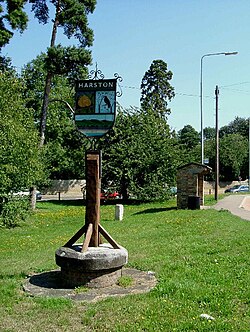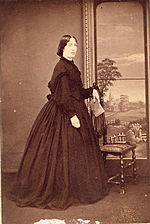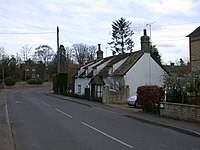Harston: Difference between revisions
Created page with '{{Infobox town |name=Harston |county=Cambridgeshire |picture=Harston village green with Harston sign - geograph.org.uk - 47348.jpg |os grid ref=TL427509 |latitude=52.138317 |long…' |
mNo edit summary |
||
| (One intermediate revision by the same user not shown) | |||
| Line 10: | Line 10: | ||
|postcode=CB22 | |postcode=CB22 | ||
|dialling code=01223 | |dialling code=01223 | ||
| | |LG district=South Cambridgeshire | ||
|constituency=South East Cambridgeshire | |constituency=South East Cambridgeshire | ||
}} | }} | ||
| Line 23: | Line 23: | ||
Although the main building is seventeenth century parts of its structure date back to at least 1480. Roman tiles have been found in the grounds and in the foundations of Harston House, supporting a tradition that a property has stood on this land ever since Roman times. The house is noteworthy for its distinctive features of English architecture, including its original Tudor fireplace, original fine wooden panelling from the seventeenth century and its rare pilasters made of clunch. | Although the main building is seventeenth century parts of its structure date back to at least 1480. Roman tiles have been found in the grounds and in the foundations of Harston House, supporting a tradition that a property has stood on this land ever since Roman times. The house is noteworthy for its distinctive features of English architecture, including its original Tudor fireplace, original fine wooden panelling from the seventeenth century and its rare pilasters made of clunch. | ||
[[File:Henriettalanghorne(long)1836-1869harstonhallcambridge.jpg|left|thumb|150px|Henrietta Long of Harston Hall]] | |||
The Wale family owned Harston Hall in the seventeenth century. The family were subsequently Lords of the Manor of the Tiptofts close by. | The Wale family owned Harston Hall in the seventeenth century. The family were subsequently Lords of the Manor of the Tiptofts close by. | ||
During the second half of the nineteenth century the house was owned by William Long (died 1883), whose wife was Henrietta Bridge, a direct descendant of Gregory Wale. One account of the Long family describes them thus: | During the second half of the nineteenth century the house was owned by William Long (died 1883), whose wife was Henrietta Bridge, a direct descendant of Gregory Wale. One account of the Long family describes them thus: | ||
| Line 35: | Line 35: | ||
[[File:Cottage in Church Street - geograph.org.uk - 713613.jpg|right|thumb|200px|Cottage on Church Street]] | [[File:Cottage in Church Street - geograph.org.uk - 713613.jpg|right|thumb|200px|Cottage on Church Street]] | ||
==Outside links== | ==Outside links== | ||
{{Commons}} | {{Commons}} | ||
Latest revision as of 21:54, 5 June 2016
| Harston | |
| Cambridgeshire | |
|---|---|

| |
| Location | |
| Grid reference: | TL427509 |
| Location: | 52°8’18"N, -0°5’5"E |
| Data | |
| Post town: | Cambridge |
| Postcode: | CB22 |
| Dialling code: | 01223 |
| Local Government | |
| Council: | South Cambridgeshire |
| Parliamentary constituency: |
South East Cambridgeshire |
Harston is a village in the meadows of southern Cambridgeshire, to the south of Cambridge. It sits just southwest of its neighbour, Hauxton, both in the space between the two branches of the River Cam; the Granta and the Rhee, shortly before they unite. The old heart of Harston by the church lies along the banks of the Rhee.
History
In the Domesday Book Harston is stated as under the Thriplow Hundred and has 29 households.
Harston House
Harston House is a historic private house in Harston. It was formerly known as Harston Hall. It is Grade II* listed.[1]
Although the main building is seventeenth century parts of its structure date back to at least 1480. Roman tiles have been found in the grounds and in the foundations of Harston House, supporting a tradition that a property has stood on this land ever since Roman times. The house is noteworthy for its distinctive features of English architecture, including its original Tudor fireplace, original fine wooden panelling from the seventeenth century and its rare pilasters made of clunch.

The Wale family owned Harston Hall in the seventeenth century. The family were subsequently Lords of the Manor of the Tiptofts close by.
During the second half of the nineteenth century the house was owned by William Long (died 1883), whose wife was Henrietta Bridge, a direct descendant of Gregory Wale. One account of the Long family describes them thus:
"Sir. W. Graham Greene's mother came to the house in 1891 and soon afterwards (1893) she bought it from the Longs after the death of Mrs. Long. It had been in the hands of the Long family for some time and was known in those days as the Long House of the Longs. Mr. Long was a very tall man and had sons who were all over six feet in height. He was a great character and many stories are told about him. He used to add to his already great height by walking around his garden on stilts and this enabled him to see what was going on over the garden wall. Some legends belonging to the time of the Civil War have been told of Harston House but they carry no conviction Formerly a large brick dove cote stood at the end of the orchard but was unfortunately pulled down by Mr. Long. Its huge foundations still trouble the gardener in his digging operations and it was this Dove Cote which was large enough to seat fifty men when the Horkey feasts were held there. Tradition has it that the Dove Cote was built on the site of a Roman villa".
In 1893 the house was bought by Sir William Graham Greene who helped to establish the Naval Intelligence Department prior to the Second World War. The author Graham Greene used to come to Harston House to spend his summers with Sir William (his uncle). The garden at Harston House provided the setting for his 1963 short story Under the Garden. According to Graham Greene's description of his childhood:
"It was at Harston I found quite suddenly I could read — the book was Dixon Brett, Detective. I didn't want anyone to know of my discovery, so I read only in secret, in a remote attic, but my mother must have spotted what I was at all the same, for she gave me Ballantyne's The Coral Island for the train journey home — always an interminable journey with the long wait between trains at Bletchley…"

Outside links
| ("Wikimedia Commons" has material about Harston) |
References
- ↑ National Heritage List 1317695: Harston house and part of garden wall
- Helen C. Greene (compiler) (1937). Harston — History and Local Records of a Cambridgeshire Village.
- Reverend Henry John Wale M.A. (1883). My Grandfather's Pocket Book. From A.D. 1701 to 1796. London: Chapman and Hall.
